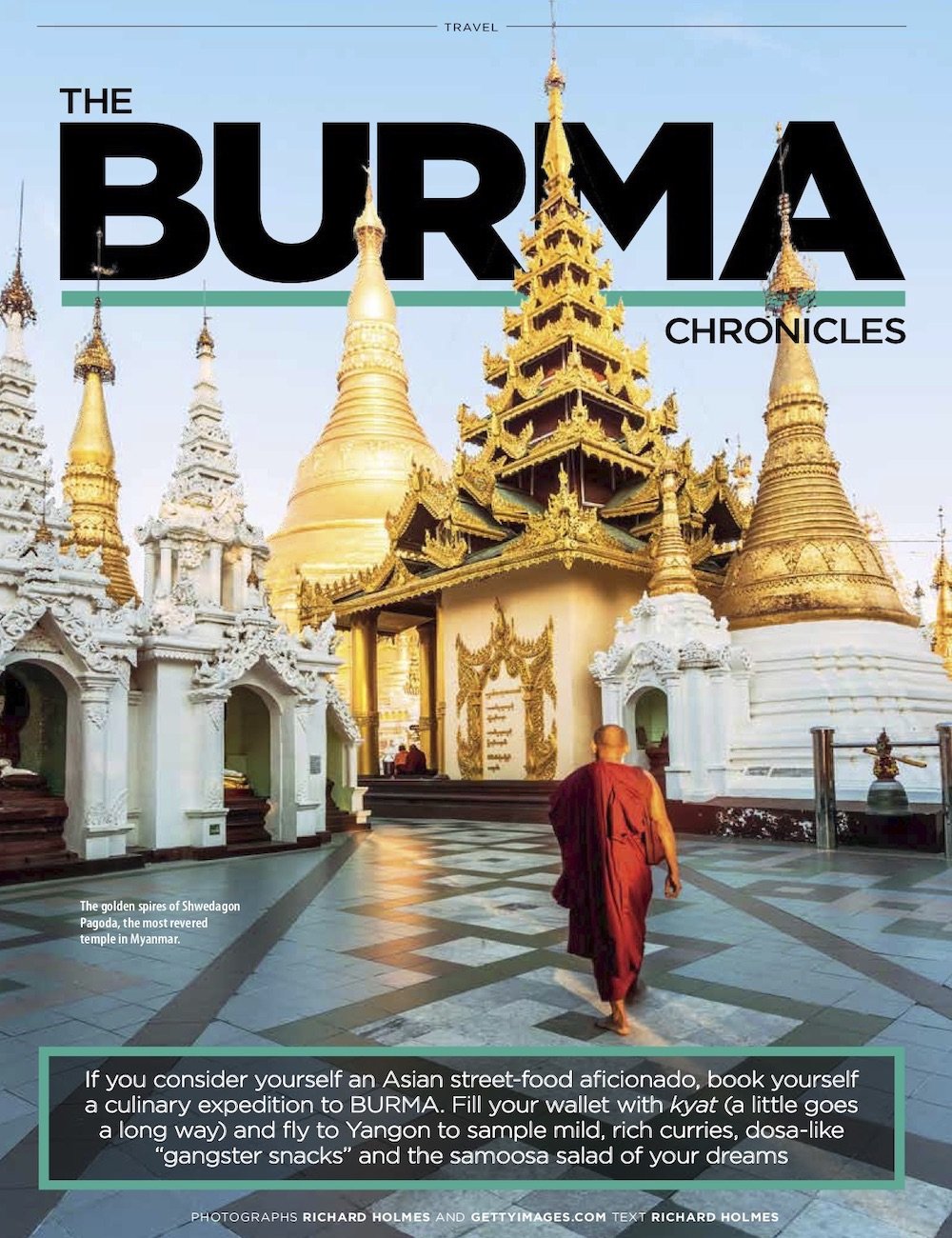First published in Taste magazine (SA).
Her hands worked as quickly as the traffic speeding past my plastic stool on the pavement. Snip-snip-snip, and the cubes of samosa, crisp and golden from the bubbling oil, dropped into the colourful plastic bowl.
On top went a scattering of fried chickpeas. Next, a spoonful of fried shallots, a sprinkle of grated cabbage, and a few slices of turmeric-stained potatoes. A flick of the wrist to mix it all, and the dish was done. A samosa salad to remember.
This wasn’t in one of the city’s buzzing noodle bars or charming teashops. Rather, a makeshift kitchen on Merchant Road; one of the innumerable anonymous food stalls that sprout on almost every street corner in downtown Yangon.
Here charmingly faded colonial buildings line wide streets where fruit sellers tout fresh strawberries, sweet bananas and dubiously pungent durian. Green mango is sliced and dipped in packets of salt and chilli powder, while at a street cart quail eggs are deep-fried in rice-flour batter and topped with sprinklings of spring onion. An assault of aromas, but where to begin?
A good place to start, I discover, is the Rangoon Tea House (RTH).
Tea houses are common across Myanmar; a relic of the country’s days as a British colony when Indian clerks and workers were brought across the Bay of Bengal to help run the Empire.
“Tea shops have always been a social space, like the British pub. Our menu is inspired by the tea houses across Myanmar, and although the space is modern the food is traditional,” explains co-owner Htet Myet Oo.
Myanmar-born, but raised in England, Htet returned to Yangon four years ago, inspired by the British chefs who were redefining British cooking. The menu at RTH attempts to do the same for Burmese food, from pea paratha to mohinga.
“Mohinga is our national dish,” laughs Htet. “Ask anyone in Yangon for their favourite and you’ll get a different answer each time.”
Mohinga is a breakfast staple across Myanmar, and although this noodle soup comes in many guises it’s always built on a base of fish broth thickened with chickpea flour, topped with rice noodles, fish sauce, lemongrass and lentils.
At Rangoon Tea House that recipe includes 29 different ingredients, and the quality of fish is key. Here their recipe blends the sweetness of local catfish with rich daggertooth.
“By being generous with each dish we’re trying to look back to the golden age of tea shop food. Back to a time when ingredients were not stifled by cost and accessibility,” adds Htet.
Myanmar’s decades of economic stagnation and isolation under military rule certainly did little to further its culinary reputation, and today Burmese cuisine stands in the shadow of Thai, Indian and Malaysian food.
As in those countries, the cuisine of Myanmar is the sum of its regions. As you travel across the country dishes evolve and disappear, replaced with regional specialties.
What they have in common is rice as the cornerstone of the meal, and a palate leaning towards sour and savoury flavours. Burmese curries are also typically milder than those in neighbouring countries, and don’t be surprised if they arrive topped with a thick layer of oil.
“Yes, traditionally Myanmar food is very oily,” sighs Sonny Aung Khin, owner of Padonmar Restaurant and founder of the Myanmar Ethnic Restaurants Association. “For the Burmese it’s a tradition that shows generosity, and the locals are proud when the food arrives in a lot of oil.”
To offset the oiliness, a Burmese meal is typically served with an array of side dishes. Piquant salads, a bowl of vegetable broth, pickled vegetables, a plate of Asian eggplant and crunchy okra, an array of dipping sauces and the pungent fish paste known as ngapi. To finish, simple lumps of jaggery, or palm sugar.
Tealeaf salad – known as lahpet – is another favourite found widely across southern Myanmar, the bitter fermented leaves mixed with dried shrimp, garlic, tomato, sesame and crispy fried broad beans.
It’s a popular dish at Rangoon Tea House, where the chefs add their upmarket touch to the dish common at street markets across the country.
“We’re trying to show that street food doesn’t just have to be seen as the food of the poor,” adds Htet. “We are part of a food ecosystem, taking inspiration from the streets and creating something on the next level.”
The same could be said of Le Planteur, the smartest restaurant in Yangon. Although tables are scattered throughout the restored colonial mansion house, come evening the best seats are out on the grassy lawns a few steps from Inya Lake. Fairy lights trail from tree branches, and a birdsong soundtrack makes it easy to forget you’re a short ride from the manic streets of downtown.
The thrust of Le Planteur’s menu is French-style fine dining, reflecting Executive Chef Gil Dumoulin’s years of Michelin-starred cheffing in Paris, but the early-evening tapas menu is firmly inspired by the flavours of Myanmar’s Shan state.
“We try to take the elements of local cuisine and adapt it to our fine dining setting. The Shan tapas menu is our way to play around and, with small bites, offer a taste of Myanmar in Le Planteur,” explains Gil.
The tapas selection has a choice of options, but the taste-of-everything Shan Discovery (US$15, enough for two to share) is your best bet.
Soft tofu is typical of Shan kitchens, but here a dip in the deep fryer produces batons just crisp on the outside, yet pillow-soft within. I waste no time dragging them through the piquant tamarind dipping sauce. So too the fish balls with their turmeric sauce, or the flambéed chicken satays marinated in lemongrass and lemon juice, served with a dip of ground peanuts and coconut cream.
Aromatic pork balls are lifted by the Burmese equivalent to Chinese Five Spice, but the fritters of black banana blossom are Gil’s favourite: “We don’t eat this in Europe, so it’s always fun to discover new flavours.”
I couldn’t agree more, so I arrange to meet up with a guide from Yangon Food Tours that evening. Our mission: a taste of the street food I’d cast a dubious eye at earlier in the day.
Our first stop is the food stalls adjoining Maha Bandula Park.
“This? We just call it a gangster snack,” jokes James, as the savoury pancakes come flying out of the skillet. “It’s what all the street gangsters eat.”
Similar to an Indian dosa, it arrives peppered with garam masala, chickpeas and soya beans. Add a sprinkle of cabbage, bean sprouts and spring onion and you’re good to go. There’s a sweet version too, with shredded coconut and palm sugar syrup, but that doesn’t seem quite so gangster.
But then neither am I, as I skip the Myanmar-style fondue; simmering cauldrons of pork broth fenced in by skewers of tripe. Instead, we head for King Tea House on Sule Pagoda Road.
“These are the best Shan noodles in town,” says James as bowls of flat sticky rice noodles arrive, bathed in a shallow broth of turmeric, spring onion and coriander. Topped with onions, peanuts and soft Shan-style tofu – made from gram flour, not soya beans – and served with pickled vegetables on the side, it fast becomes one of my favourite Burmese dishes.
Back on the street we snack on coconut-sprinkled pancakes and sesame-covered rice balls on our way to 19th Street in Yangon’s Chinatown. Tables here crowd the street between rows of open-air barbecues. Restaurants lay out trays of whole fish, chicken satays and prawns threaded onto long bamboo skewers, all ready and waiting for the grill. But it’s late and time to head home. Tomorrow, there’ll be more noodles for breakfast, more sweet tea and more hours walking the streets. And, with any luck, another bowl of that unforgettable samosa salad.





























